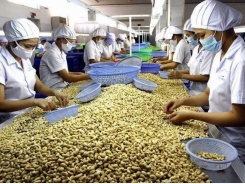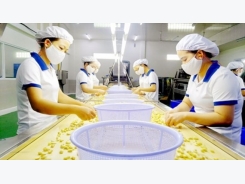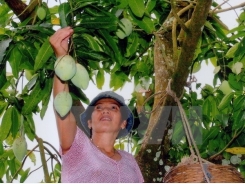Expanding export markets for agricultural products

Illustrative image
In 2017, the agriculture sector is facing two major challenges including the complicated situation of climate change and increasing competitiveness in the market. In order to improve on the 3% GDP growth in 2016, with export revenue of just US$33 billion, the agricultural sector is prioritising the restructuring of production to meet the market demand and adapt to climate change.
Remarkable progress
Over recent times, thanks to the close attention of the Party and State, the active coordination among the relevant sectors and branches, as well as the efforts of farmers in implementing agricultural restructuring, challenges have gradually been resolved. In the first six months of 2017, the agricultural sector reached 2.65% of the 3.05% growth target and export revenue reached US$17.1 billion, with almost all major industries meeting the target.
In the first half of 2017, export turnover of agro-forestry-aquatic products hit US$17.1 billion, up 13.1% annually. During the first half of the year, earnings from the export of farm produce were estimated at US$9.1 billion, up 15.4% annually. Meanwhile, revenues gained from aquatic and forestry product shipments reached US$3.5 billion and US$3.8 billion, an increase of 14.1% and 12.8% respectively.
Vietnam exported 413,000 tonnes of rice worth US$182 million in June, raising the six-month volume to 2.8 million tonnes and the value to US$1.2 billion, up 6.3% and 4.9%, respectively. China remained the top importer of rice from Vietnam.
Aquatic products worth US$3.5 billion have been shipped abroad since the beginning of this year, predominantly to the US, Japan, China and the Republic of Korea, marking a 14.1% rise.
Vietnam also saw a significant rise in exports of fruit and vegetable products in the first half of 2017. According to statistics provided by the General Department of Vietnam Customs, exports of fruit and vegetable products hit over US$1.68 billion in the first six months of 2017, an annual increase of 41.4%. The country has enjoyed impressive growth in fruit and vegetable exports in certain foreign markets, including the UAE (93.6%), Hong Kong (China) (89%), and Laos (69%).
Thanks to the close instruction of the Government, many banks and credit organisations, such as the Vietnam Bank for Social Policies, the Vietnam Bank for Agriculture and Rural Development (Agribank), have deployed a number of loan packages to boost agricultural production and export. In the first six months of 2017, Agribank’s total outstanding loans reached VND788.588 trillion and loans for the agricultural and rural development sector reached VND578.652 trillion, accounting for 73.4% of the total outstanding loans. In particular, investment in agricultural exports accounted for VND7.7 trillion, with over 480 customers.
Overcoming difficulties
Through fact finding missions in a number of localities, in the context of common challenges, many branches and localities have quickly found new solutions, changing their export strategies to overcome difficulties.
In the northern region, in the first six month of 2017, a number of key export products, exported through the border gates in Lang Son province, such as watermelon, dragon fruit, banana, cashew nut and cassava starch, saw a decline in export revenue over the same period last year. However, a number of local products that were exported to China including sweet fennel, tea, black agar, and pine resin recorded higher export revenue to the Chinese market. In the past few months, local enterprises have been more active in promoting the export of local goods. According to the statistics from the Lang Son provincial Department of Industry and Trade, in the first six months of 2017, turnover from flower exports reached about US$15 million, up approximately 12% over the same period last year.
According to Director of Lang Son Agricultural Products Processing and Export Co. Pham Thu Giang, the company has actively exported sweet fennel to China and a number of other markets. The company's sweet fennel product has been registered and issued with geographical indications, as well as being protected by the State.
Deputy Director of the Lang Son Department of Industry and Trade Nguyen Quoc Hai said that thanks to the advantages of tax incentives in the China-ASEAN trade agreement, local agricultural products are actively promoted by exporters. Specifically, in the first six months of the year, local export revenue reached US$44 million, recording an annual increase of 23.9%.
In the Mekong Delta province of Long An, from the beginning of 2017, consumption of agricultural products has been stable. In addition to key export products such as dragon fruit and rice, the seedless breed of lime has become increasingly popular. So far, local farmers have planted more than 9,000 hectares, of which the fruit producing area is about 6,000 hectares, with an average yield of about 182 tonnes per hectare a year, and total output is estimated at over 110,000 tonnes a year. Currently, 35 units and two orchard cooperatives are organising the production, purchase and consumption of seedless limes in the Long An province. The product has been exported to Thailand, Malaysia, Singapore, Europe, China and the Middle East, bringing in export revenue of over US$45 million a year. In particular, orders for seedless lemons from fruit traders have increased after the cooperatives applied the VietGap standards for production of the fruit.
Meanwhile, the livestock industry has been facing difficulties over recent months, which is mainly due to supply exceeding demand, but more specifically due to low product quality and such products having not reached markets of high demand, along with high costs, especially in feed. Ensuring hygiene and safety, and limitations in preservation and processing, have also negatively affected the livestock sector. In order to resolve the existing problems, it is necessary to quickly invest in concentrated and modern processing establishments; expand the market to find an output for Vietnamese livestock products; and continue to improve the legal system to encourage businesses to invest in the livestock sector, especially in processing facilities. In addition, local enterprises should continue studying the market to create diversified products and improve competitiveness. They also need to study and expand investment to create a complete value chain from feeding, breeding, slaughtering, processing and preservation.
Có thể bạn quan tâm
Phần mềm

Phối trộn thức ăn chăn nuôi

Pha dung dịch thủy canh

Định mức cho tôm ăn

Phối trộn phân bón NPK

Xác định tỷ lệ tôm sống

Chuyển đổi đơn vị phân bón

Xác định công suất sục khí

Chuyển đổi đơn vị tôm

Tính diện tích nhà kính

Tính thể tích ao hồ




 Rice recovery no cause for cheer
Rice recovery no cause for cheer  Major farm produces enjoy rise in export value…
Major farm produces enjoy rise in export value…